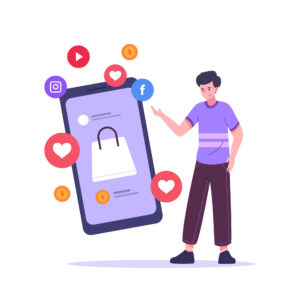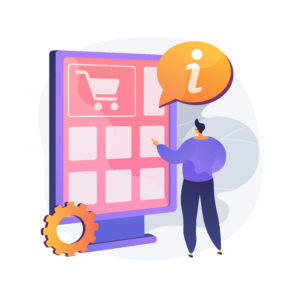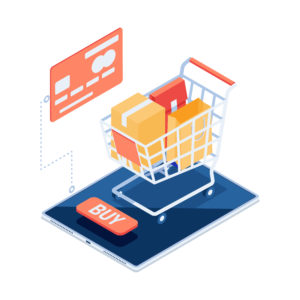Updated in October 2021.
Every annual holiday is an opportunity to engage with your customers and drive sales, yet nothing beats the celebrations streak during the last quarter of the year.
The holiday “commercial” season formally begins in October, with Halloween, continues with Black Friday and encompasses a slew of holidays up until Christmas. You definitely don’t want to miss the seasonal promotional opportunities to maximize your online sales, especially considering your competitors have probably started preparing already.
It’s worth noting that following Covid-19, more than 50% of Americans plan to shop online on Black Friday and Cyber Monday—compared to less than a fifth looking to shop in-store. Across the board, consumers are becoming more and more interested in shopping online. While this is great news for eCommerce, it means the landscape is more competitive than ever.
To help you plan for the festive season, here’s a list of the major 2021 year-end holidays to keep in mind:
October 31th – Halloween 🎃
November 4th – Diwali 🪔
November 11th – Veteran’s Day 🏅
November 25th – Thanksgiving 🦃
November 26th – Black Friday 🛒
November 28th – First day of Hannukah 🕎
November 29th – CyberMonday 💻
December 13th – Green Monday 🛒
December 14th – Free Shipping Day 🚚
December 25th – Christmas Day 🎅🏼
December 26th – Boxing Day 🎁
December 31st – New Year’s Eve 🎇
That’s a lot of special days to pick from and plan for, but they’re also great opportunities to tap into this year’s projected holiday sales online revenue of $207 billion—an 11% increase compared to 2020, despite the pandemic.
Once you’ve decided which holidays to target—and don’t worry, our guide will help plan and execute optimally—and have your product stocks ready, it’s time to get into the game! Whether you’ve already started planning your holiday campaigns, aren’t sure how to begin, or are simply looking for ideas to squeeze those last dollars out of customers, we’ve compiled 15 tips to guide your holiday eCommerce sales in 2021.
Rather than adding to the holiday noise, let’s look at how you can delight customers and maximize your returns on all marketing spend this winter.
#1 Start planning your campaigns now
The best time to plan your holiday campaigns was 6 months ago. The second best time is right now.
Last year a National Retail Federation survey found that 42% of US shoppers had started their holiday shopping earlier than usual. By early November, more than a quarter of all holiday shopping was already complete.
While certain blockbuster days will continue to dominate the headlines (looking at you, Cyber Monday) holiday shopping has been moving earlier for years. But in 2021 we’re expecting an even bigger leap. Global supply chains are in disarray, tech goods are facing a global shortage of parts and processors and shipping is an unqualified disaster—in spite of these aspects, holiday readiness is at an all-time high and shoppers will be working as fast and efficiently as possible on their shopping.
Successful campaigns take time to prepare
The second—and arguably even more vital—reason to plan your campaigns early is that executing a top-quality advertising, social media or marketing campaign takes time. Rushing any part of the process is likely to impact results.
Finally, holiday marketing is a busy season. The more you can plan, strategize and tick jobs off the list before the real rush comes in winter, the better placed you’ll be to implement the rest of our tips.
#2 Give your website a holiday makeover
Show consumers that you’re embracing the holiday spirit by using your homepage to feature special deals and holiday-themed products. You should strategically show off your best products and make the offerings as appealing as possible. Remember that sale items are the main thing shoppers look for when browsing a website during the holidays, so your discounted items should be prominent.

There are some subtle changes you can make to your website in order to build that festive hype:
- Change your logo to incorporate the upcoming holiday (especially powerful at Christmas and Halloween)
- Add festive “trimmings” to your website (e.g. snow at Christmas or poppies on Veterans Day)
- Adjust your color palette and site imagery to match the season or holiday
- Touch up your copy with festive words, phrases, and even puns to create an appropriate tone
#3 Optimize your website’s performance
Once your website is looking good, it’s crucial to optimize its performance. While Amazon’s much-quoted stat, “for every 100 milliseconds of webpage load time there is a 1% drop in sales”, might not be totally accurate, the message is still relevant today.
More than half of shoppers will abandon websites that take more than 3 seconds to load. While there are a few tips & tricks you can employ in-house (see below) we strongly recommend bringing in outside help to make sure your site is fast, bug-free and ready to roll with the punches. Simple load testing at 500% traffic (or more) will help determine whether you’re ready for the holiday rush.
The cost of hiring speed optimization experts pales in comparison to what you could lose due to server failure or slow loading. Giants like Walmart and fashion brand Lululemon both experienced site crashes during Black Friday, missing out on huge revenue bumps. In 2019 Costco lost a predicted $11 million in revenue after a 16-hour post-Thanksgiving outage.
Google has even made mobile page speed a search engine ranking factor. So you are doubly incentivized to speed things up as it will positively impact your site’s SEO.
Emergency DIY speed optimizations
- Asynchronous loading—Synchronous loading means that the web page only appears when every element is fully loaded. Switching to asynchronous loading can give the illusion of faster loading speeds (with segments appearing as soon as they’ve loaded) and help deter would-be absconders from leaving your site.
- Image optimization—Large image files cripple your site. Create web-appropriate versions of all images to keep the site as unburdened as possible—users will not notice any quality difference and will appreciate the rapid browsing.
- Third party integrations—Keep front-end third-party apps to a minimum. These integrations (for example, social media feed plugins) can add value to visitors, but they can also slow down your site.
Bonus: Here are more tips to improve the performane of your eCommerce website!
#4 Optimize everything for mobile
You absolutely must prioritize mobile user experience on your website during this holiday season. Mobile spending over the 2021 holidays is set to hit $70 billion, claiming just under a third of all online holiday shopping in 2021.
Optimizing your website for mobile is partly the technical robustness we mentioned above, but it’s the user experience that lets most retailers down.
Your website needs to offer a streamlined shopping experience all the way through to your shopping cart and checkout. Here are some mobile website and shopping cart best practices to maximize your conversion rates and revenue growth:
- Make your product search box larger and more prominent
- Allow autofill of contact and card details in the cart
- Emphasize product reviews & social proof—remember that product reviews are one of the most important factors influencing the decision to buy in 2021
- Show the price in the buyer’s local currency, both on the website and in the shopping cart
- Make sure the discounts on your website are reflected in the cart
If you have a mobile app, you need to repeat everything you’ve done for the website: stress test extensively (to make sure it’s functioning properly and capable of handling the increased demand over the holidays) and go hard on the user experience design so it’s as easy as possible for shoppers to buy from you.

#5 Get your discounts right
If all you do is dress up your website a little and offer a few small discounts, you shouldn’t expect any miracles. During the holiday shopping season, customers are counting on getting crazy good deals, more of the “you’d be crazy not to grab this deal” or “offer you can’t refuse” type than just a generic 10% off.
However, that doesn’t necessarily mean offering an 80% discount; it can also involve cross-selling and up-selling, bundling items and so on. Most people are looking for the right price for them, at that moment in time—not necessarily the lowest price ever. You can also add exclusive or time-limited deals, thus creating a sense of urgency.
Offer value without discounting
As well as cutting prices, there are multiple holiday eCommerce promotions you can launch without “discounting” per se:
- Raffles—Partner with a third party (to create something unique) or put one of your products up as a raffle prize. Entries to the raffle are awarded for “free” following any on-site purchases during the promotional period. The number of entries can scale with the size of purchase.
- Gift Certificates—Offering gift cards as a purchase reward is an excellent way to increase average order value, by incentivizing spending a certain amount (e.g. “Spend $45 and earn a $5 gift card”), or customer lifetime value, since a customer with a gift card is very likely to return and spend in future.
- Free shipping—Free shipping has become a bit of an artificial discount for many companies. Because free shipping is now expected as standard, companies usually offer it for purchases above a certain level, e.g. “Spend $50 and we’ll ship for free.”
- Special discounts—This one is a little different: only offer a discount once the order total reaches a certain level. For example, $10 off if you spend $100.

You should always calculate the magnitude of your discounts based on your financial model, previous sales results and ROI forecasts, to make sure the deals will actually generate profit instead of net losses at the end of the holiday period.
#6 Make sure your analytics are running smoothly
If you’ve promoted your campaigns well, you’ll likely receive a lot of traffic over the holiday season that leads to conversions and micro-conversions. It’s important to make sure everything’s working fine with your analytics so you can monitor your website’s performance, traffic, purchase flows, and so on.
This will allow your team to effectively optimize campaigns on the fly. If you notice certain flows are performing better than others, for example, you can put more funds behind them. You can launch cart abandonment email campaigns with deadly accuracy (since you know exactly when carts are being abandoned, and with which products) and even use your analytics to accurately forecast and manage your supply chain.
To take things a step further, you could implement dynamic tools which help forecast demand, plan inventory, automate certain operations and even optimize prices in real-time. Such technologies can facilitate a more seamless buying journey for customers, especially if your business combines both eCommerce and physical retail stores.

#7 Get personal
It’s more important than ever for brands to stay consistent across channels and provide personalized experiences.
Personalization doesn’t mean creepily using the prospect’s full name; the most impactful thing eCommerce businesses can do is leverage shoppers’ previous browsing behavior to personalize offers. Either on your website or through paid social media and search ads.
Not only should you see good conversions from this targeting, you’re also increasing raw traffic to the site and can use up-selling and cross-selling with related products and accessories on cart pages. Building campaigns that focus on customers who either haven’t purchased in a while, or those who engage particularly well with emails, is another option.
Get personal to improve brand engagement
You can also interact with your customers by encouraging them to share their purchases and reviews through their own social channels, in order to extend your brand awareness and trust. Buyer behavior surveys have shown that brand reputation and product reviews are some of the most important factors that influence the decision to buy.
Finally, give shoppers reasons and opportunities to tell you about themselves. The more you know about them, the better you can personalize their experience. This isn’t necessarily about increasing holiday eCommerce sales in 2021—but in 2022, these might well be valuable customers!

#8 Make a big splash on social media
The holiday season is a great chance to engage with and expand your company’s following on social media, both to improve your brand’s reputation and directly impact sales (in a positive way, of course). Let’s look at how you can nail both.
Social media for brand engagement
This is one of the few times every year where you can let loose on social media. It’s crucial to understand that over the holidays, shoppers expect creative, enjoyable interactions with brands. So let the shackles off and get creative:
- Run festive contests—Put up a product or special offer as a prize, then run an easy and fun contest that, rather than focusing on generating leads with contact information, just tries to engage as many people as possible. Try to get them invested, make them laugh, make them think—these interactions can put your brand front-of-mind when it comes time for shopping.
- Let the banter flow—No joke, simply sitting behind your Twitter or Instagram for a few hours replying to messages, poking fun, “warring” with other brands, and providing social commentary can create seriously good vibes for the company.
- Create amusing holiday ads—You don’t need a big budget to cobble together a funny or emotional video. These always have the potential to go viral and, if not, can build a stronger bond with your like-minded followers, reminding them that you’re the kind of brand they should be getting behind.
Of course you need to keep up the effort post-holidays to keep your new cohort of fans engaged!
Social media advertising
Here’s where some companies go wrong. They know that the holidays are a great time for whimsical humor and festivities—and so they pile this into their paid advertising too.
Be careful with festive ads!
All year round, your company has a focus on building ads based on data: purchase history, demographics, pain points, objections, competitor analysis, etc. Your ads need a good return or you’re just burning money.
So during the holidays, you must remember to still be strategic in your paid advertising. Try to personalize (see previous section) if you can; address known pain points of your audience; inject festive spirit only if you think it will resonate and help conversions on these specific campaigns.
Because while festive cheer is huge over the holidays, it doesn’t need to bleed into every aspect of your business. Sometimes, even at Christmas, the most effective ads are those which don’t mention the holidays at all—they just focus on selling the right products, at the right time, to the right people, at the right price.

#9 Create and promote a holiday shopping guide
The basic idea of a holiday eCommerce guide is to make buying decisions easier for shoppers—and in 2020, over 45% of people said they’d be looking for one! This tip is aimed at online stores which typically offer a wide variety of products.
An incredible number of people are determined to buy gifts and have no idea where to start. Your shopping guide is what they need: it simultaneously creates ideas, provides buying options, and converts shoppers into customers. It’s a great add-on for marketing campaigns and a useful tool for re-engaging past customers or cart abandoners.
To create the guide, you just need to follow basic marketing principles:
- Choose the right products—Speak to customers, review historical sales data, ask stockists which products are trending. Find the products most likely to be popular this winter (or summer, if you’re targeting shoppers from the Southern hemisphere).
- Categorize your products—If you’re making one shopping guide, you’re probably making several. Categories could be by:
- Age
- Product type
- Interest or personality
- Budget
- Gender
- Virtually anything, depending on your specific business
- Choose a format—Landing pages, downloadable lead magnets, PDFs, blog articles, hard copy for direct mail; the format isn’t too crucial as long as it’s easy for shoppers to access and reference.
It’s then time to stock up on the products you’re advertising and start sharing the guide. Like any campaign, this can be done organically (through social media, SEO, word of mouth) or using any form of paid advertising.
Holiday eCommerce guides are designed to capture those buyers that don’t really know what they want, and who want the thinking done for them. And there’s a reason so many eCommerce businesses publish guides—they work!

#10 Leverage affiliates
The holiday season is the loudest, busiest time of the entire year when it comes to marketing. Remaining visible and cutting through the noise can be difficult when shoppers are sick to their back teeth of ads!
One brilliant way to get your products seen is to go through third parties that prospects actually want to listen to: affiliates. If you haven’t previously engaged niche brands, popular websites or influencers as affiliate partners, now is the perfect time to start.
Bonus: Here are some tips on maximizing eCommerce sales using affiliates.
Affiliates already have a firm grip on their audience’s attention. By arranging a mutually-beneficial deal, both sides can benefit from increased profits over the holidays. There are two basic “keys” to effective affiliate marketing:
- Audience fit—You need to be putting your products in front of the right people. This doesn’t mean existing customers (that would be redundant) but those with an active interest in your niche. For example, if you sell online courses, you might target bloggers or YouTubers in the personal development niche.
- Audience size—Bigger does not always mean better when it comes to affiliates. The reason? Smaller followings are usually more engaged and trusting of the affiliate; therefore it can make sense to spread funds around 2-3 smaller affiliates than a single giant.
If you want to stand out and be seen (and by “be seen”, we mean “have your products fly off the shelf like startled pigeons”) then an affiliate partnership could be the way to go.
#11 Leverage existing customers and old prospects
We’ve already explored multiple ways to prepare for an onslaught of new shoppers—but don’t forget about the audiences you’ve previously marketed to. These split into two groups:
- Your existing customers;
- Prospects who didn’t purchase, but did show interest, in previous campaigns.
You should be retargeting your existing customers anyway—upsell offers, discounts, personalization, the works—but many companies abandon this second audience. In earlier campaigns you probably had prospects engaging with your marketing, visiting the website and even abandoning their cart.
In marketing you need to hit the right prospect, with the right offer, at the right time—but you can only control two of these variables. Allocate some of your holiday marketing budget to those prospects who showed interest but never made a purchase earlier in the year. Get as personal as you can—there’s a good chance the holiday season will be the right time for them!

#12 Provide stellar customer support
During the holiday season, one issue is perennial: customer requests for support tend to surge dramatically. Companies might get overwhelmed by the increased number of orders and customer service tickets and requests.
The first thing you should do is check last year’s trends, to know what to expect. Also, narrow down the main channels that customers are using to ask for support or send complaints—email, social media, your helpdesk platform?
If you think adopting a new channel will bring a net benefit to customer support (even if it’s temporary over the holidays) then make the decision early enough to integrate the channel and train your staff. Live chat, for example, has become the de facto standard for eCommerce support in recent years.
Make sure your customer support team is very well trained and prepared to deal with difficult customers and stressful situations, and that your escalation infrastructure works properly. You might need extra hands on deck, or extra hours of work, at all levels of the company. If customers don’t get the help they need, when and where they need it, they may well avoid your business in the future; you might also acquire a negative reputation online.
As long as your team is prepared and understands how to use any tools & software at its disposal, the holiday rush should cause minimal ruckus. Implementing our other advice such as optimizing the website will also contribute to smooth festive sailing.

#13 Optimize your site for search
Enabling effective site search is not a UX box-ticking exercise: it’s a mission critical part of your online sales capability. Conversion rates through site search can be up to 50% higher than the average.
Site search is becoming the dominant way in which shoppers find specific products in your store. For some eCommerce sites, as few as 10% of shoppers using the search function can account for 40% of revenue. Effective site search brings:
- Lower bounce rate
- Higher conversions
- Better user experience (especially for mobile users)
- Valuable analytical data (for future campaigns)
- A faster shopping experience
There are a few simple optimizations you can implement to create much more effective site search:
- Use query suggestions (aka Smart Autocomplete) to help customers fine-tune queries and connect with your products faster. This simple change can boost sales and conversions by as much as 24%.
- Provide relevant filtering options for every search.
- Design for user experience. Colors, fonts, microcopy—there are lots of minor adjustments which, combined, can significantly improve ease of use.
Bonus: Here’s how to perform a thorough SEO audit for your eCommerce store!
#14 Optimize checkout and payment infrastructure
If you think shoppers clicking “Add to basket” then “Go to checkout” means you’ve got a sale, you’re wrong. Roughly 70% of shoppers abandon their carts; some sources put this as high as 90% during the holidays.
There are many reasons why this happens. Some of them you can’t control (like shoppers getting distracted by an emergency phone call) but the vast majority can be addressed. Here’s a quickfire list of extremely common checkout problems and how you can fix them:
- Forced account creation—The argument against guest checkout (where shoppers don’t need to register an account) is that you lack customer info which makes future marketing more difficult. However, it massively increases cart abandonment—and you can’t market to shoppers who never bought from you! We recommend guest checkout with the option to register post-purchase.
- Unexpected shipping costs or taxes—You absolutely must show both product and shipping costs (even an estimate) before reaching checkout. When a shopper reaches the checkout page and the numbers don’t match what’s in their head, they are instantly mistrustful.
- Payment security concerns—People don’t spend money if websites look suspicious. Displaying trust seals and security badges, including a link to your terms & conditions, showing the highlights of your refund policy, and displaying short reviews can all allay customer security fears.
- Discount code failures—If your company releases a promo code it has to work. Shoppers are not going to pay full price when they’ve been offered a discount. Again this will cause mistrust and possibly an unpleasant storm on social media.
- Product no longer in stock—There’s nothing worse than reserving an item in a cart, shopping around a little more, then seeing a message at checkout saying “Sorry, this item is out of stock”. Invest in accurate, real-time stock monitoring for your eCommerce store to improve conversions.
- Payment option issues—Always offer a variety of payment methods—debits cards, credit cards and some of the most popular global digital wallets, like PayPal or Google Pay, are a must. With so much shopping done on mobile, it’s common for shoppers to make purchases without their physical wallet, expecting a simple digital solution.
- Poor returns policy—As we discuss in point #15, managing returns is exceptionally important during the holidays. Free returns has become the standard: seeing your expensive or awkward returns policy can make users abandon checkout and go elsewhere. Try to make returns as attractive as possible for your customers; if you can’t offer free returns (this is a common problem for small and boutique retailers) then explain why and try to connect with prospects emotionally.

#15 Prepare for Returns Season
We know this is probably the last thing you want to hear after putting so much effort into your holiday marketing…but customers will return items. Doesn’t matter if you’re selling cars or theater tickets or digital subscriptions: come January, the returns will come thick and fast.
If that sounds daunting, here’s the good news: it’s a huge positive opportunity. Did you know 4 in 10 shoppers will make an additional purchase when returning a product online? Demonstrating world-class customer service is crucial to creating these additional sales. For some, the returns process is the first interaction they’ve had with your brand; this is an extremely important, impressionable moment.
Returns culture has changed
It’s also important to recognize that free shipping & returns has transformed how we shop. We return more products, but we also buy more products in the first place. Instead of experimenting with one dress, a modern shopper might buy 3-4, knowing they can freely return the ones they don’t want.
In reality, you’re always selling just one dress; it’s just packaged as selling 4 and refunding 3. Your goal with excellent customer service isn’t to prevent returns from happening—it’s to make them so easy that customers want to buy from you in future.
Some companies create convoluted returns processes to make customers give up on their return. Not only does this usually fail (people are very determined when it comes to returns) it’s horribly short-sighted: more than 8 in 10 online shoppers would stop using an eCommerce business after a bad returns experience.
Conclusion
To conclude, the online sales opportunities around the holidays are immense. Be ready to deliver and make sure you have a great festive—and profitable–season!
Special tip: try to “underpromise” and then “overdeliver.” This will help manage your customers’ expectations and always provide them with a positive experience.
Any tips or important holidays that we missed? Just add them in the comments!





